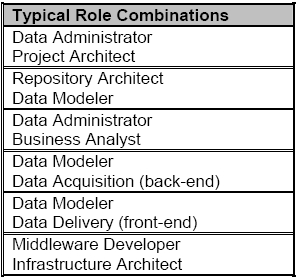Data Administration Staffing – Part 1
By
Understanding the roles and responsibilities needed for a Data Administration team is critical to the meta data repository’s initial success and ongoing maintenance. There are 9 key roles that require specific, qualified resources assigned to them in order for the team it to be successful. These roles are:
- Project Champion
- Data Administrator (project manager)
- Repository Architect
- Data Modeler
- Business Analyst
- Data Acquisition Developer (back-end)
- Data Delivery Developer (front-end)
- Middleware Developer
- Infrastructure Developer
This two-part series will present a detailed discussion on the functions performed by each of these roles and their key areas of responsibility. Meta data repository efforts differ in size and scope depending on the requirements of the corporation. In typical installations certain roles can be grouped together and served by the same resource. Table 1 presents the typical role combinations that have been effective in contributing toward successful repository projects. Keep in mind it is best to not assign more than two roles to the same resource.

Table 1 : Typical Role Combinations
In larger implementations each role will require a dedicated full-time resource, and for the developer roles multiple resources will typically be needed. Some of these roles are commonly filled by a central Information Technology (IT) infrastructure group, specifically the middleware developer and the infrastructure architect.
Project Champion
Any major, cross-departmental IT effort, whether it’s a decision support system (DSS) or if you’re implementing that hot new Enterprise Resource Planning (ERP) package, needs executive management support. Their involvement is imperative in breaking down the barriers and the “ivory towers” in all of our companies. Their position allows them the ability to rally the various departments within a corporation behind enterprise level goals of the project. Any substantial project lacking executive management participation has a high probability of failure.
Data Administrator (project manager)
The data administrator’s responsibilities include project planning, staff assembly/configuration, and setting the vision and strategy for the repository. This person needs experience leading successful meta data repository implementation efforts. They need strong communication skills, and the ability to grow and develop their staff. It’s important to realize that the project leader’s job is not to make a “star” out of everyone. Instead the data administrator’s role is to assign each resource into a role that best fits their skill sets and goals, thereby getting the most out of each employee. This person understands how to manage end-user expectations, conduct end-user training, and understand how to manage vendors (software and consulting).
The data administrator has a strong grasp on how to define standards that the other IT teams will adhere to. It’s critical to thoroughly communicate these standards and to keep them easy to understand and abide by. If these standards are not kept simple the data administration team will be looked upon as a bottleneck. Once this occurs it is a matter of time before the project fails. There is an old data administration joke (actually I believe it is the ONLY data administration joke that exists) that addresses this problem:
“What is the difference between a data administrator and a terrorist?
You can negotiate with a terrorist!”
Repository Architect
The repository architect is responsible for the technical architecture, which the physical meta data repository and the access to it, is based upon. In addition, the architect must have experience architecting successful meta data repository efforts as this person will define and enforce the construction standards that each developer (data acquisition and data delivery) will use during implementation.
The repository architect needs to know how to evaluate the physical data model used to store the business and technical meta data. In addition, the architect must follow the trends in the meta data industry, especially the battle for meta model standards between Microsoft and Oracle. Also, this person must have a deep understanding for what meta data software tools do and don’t do.
Data Modeler
The data modeler’s responsibilities include the design and construction of the meta model (physical data model) that will hold the meta data (both business and technical meta data). This person does not necessary need experience modeling meta data, rather a very good, experienced data modeler that understands multi-dimensional and third normal modeling can be quite successful when working with an experienced data administrator and repository architect.
The data modeler needs to understand the database technology used for the physical table implementation and the indexing strategies needed to speed access. Lastly, this person needs good communication skills to work with the business/technical end-users and business analysts.
It is difficult finding experienced people for some of these roles especially those of the data administrator and repository architect. If it is necessary to bring in an outside consultant make sure that the consultant is highly skilled in knowledge transfer and mentoring.
Next month we will examine the remaining meta data repository project roles and responsibilities.